 Sasaki is a popular climbing type card game which is very popular in North Korea. It also goes by the name 44A, which is also the name of a special unbeatable combination that can be played during the game.
Sasaki is a popular climbing type card game which is very popular in North Korea. It also goes by the name 44A, which is also the name of a special unbeatable combination that can be played during the game.
Sasaki uses a 48 card deck which is created by removing the four twos from one standard 52 card deck. The ranking of the remaining cards in the deck as used for this game are as follows (from high to low); Ace, King, Queen, Jack, 10, 9, 8, 7, 6, 5, 4, 3. Sasaki is designed for play by four players.
Location of seating positions at the table can be performed using a variety of methods. A common such method is to have each player draw a card from the shuffled deck, with the players taking seats in the order of rank of cards drawn (highest to lowest).
As with most card games which originated in Asia, there is no dealer and the shuffled deck is simply placed face-down in a pile at the center of the table. The player who drew the highest card during the draw draws the top card of the pile, beginning his hand. Each other player, in a counter-clockwise direction then takes the next card from the top of the pile adding it to his hand. This continues in rotations around the table until each player has drawn a total of 12 cards (which also will deplete the deck).
The players who have the two red tens (ten of hearts or ten of diamonds) form a temporary, secret, partnership during the game, playing against the other two players. The identity of these players should not be announced, and will only become apparent once those cards are played during the hand. If a player has both red tens in his hand, that player plays alone against the other three players. While this is usually not known, which players have these red tens, a player who has such a card may, if he wants, expose this card from his hand, thus announcing he has one of the red tens. The player holding the other red ten, must also expose his card, which makes the partnerships for the game apparent. These players then exchange these red tens amongst themselves. So exposing the red tens (called running), causes all scoring during the hand to be doubled. After the red tens are exposed, any member of the opposing partnership may then announce "Stop" which causes the scored to again be doubled (quadrupled the final scoring on the hand). A player who has both red tens in hand may, if he so pleases, expose both such cards in his hand, which doubles the value for all scoring during the hand. Any of the three opponents may then call "Stop" which causes all scoring on that hand to be quadrupled instead.
If the game is played during daylight hours, whichever player has the 3 of hearts in hand is entitled to make the first play, although that player is not required to use that card during that first play. Similarly, if the game is being played during evening hours, the player who has the three of spades in hand makes the first play, and that play need not necessarily contain the three of spades.
After this first player makes his play, each player, in a counter-clockwise direction then has a turn. If that player can, and chooses to, play a higher combination than that player he may do so, making his play to the table. If he cannot (or chooses not to) play a higher combination, that player must pass. The game continues with each player, in a clockwise direction having the opportunity to make a higher play. In so playing, a player must make a play which is higher ranked than any previous play during that same round. This continues until three players, in consecutive order pass on their turn. The cards from the center of the table are then set aside, out of play. The player who played the highest combination on the last round, then starts a new round of plays, playing any combination of cards from his hand. In order to be considered a higher (and thus legal) play than a previous play, the card or combination must be considered a higher rank play. The following chart shows the legal standard combinations that can be played during the game, and how that combination is ranked:
| Card Combination | Description of Combination | How Combination is Ranked | Example |
|---|---|---|---|
| Single Card | This is any one card played from the hand to the table. | In order to be considered a higher play than a previous play of this type, a player must play a single card of a higher denomination. The suit of the card does not matter. | 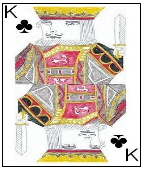 |
| Pair | Two cards of the exact same denomination. | A pair may be beaten by a higher ranking pair. | 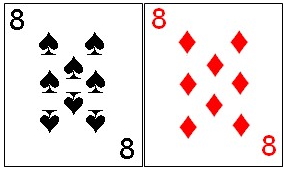 |
| Sequence | Three or more cards, of any suit, in direct sequential ordering. | A sequence can be beat by another sequence, containing the exact same number of cards, in which the highest card in the sequence is higher than the highest card in the previous high sequence. |  |
In addition to these three standard combination types, there are also several special combinations which can often be played to beat standard combinations or each other. The following chart shows these combinations:
| Card Combination | Description | Combination Ranking | Example |
|---|---|---|---|
| Triplet | Three cards, all of the exact same denomination. | A triplet can beat another triplet containing lower ranked cards. In addition, a triplet will beat any other standard combination. | 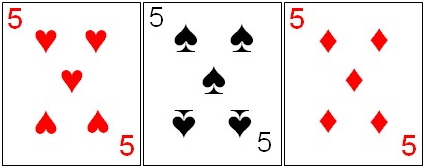 |
| Sasaki | This special combination, from which the game takes it's name, consists of two fours and one Ace. It is also known by it's alternate name (and also an alternative name for the game), 44A. | This combination can beat any normal combination as well as any triplet. | 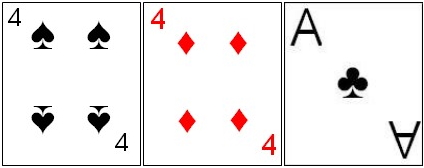 |
| Four of a Kind | Four cards, all of the exact same denomination. | A specific four of a kind will beat any four of a kind consisting of lower cards. In addition this combination can beat any normal combination, any Sasaki or any triplet. |  |
| Pig | A pig is the two red tens (ten of diamonds and ten of hearts). | This is normally the highest combination in the game, with only other combination by which it can be beaten. Thus, this combination can be played by a player on his turn to beat any other combination. | 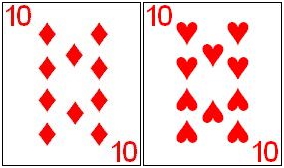 |
| Black Pig | A black pig is a special combination consisting of the two black tens (10 of clubs and 10 of spades). | Normally, this combination is simply considered an ordinary pair of tens, and can be beaten by any other higher pair or a higher special combination. However, it is the one, and only, combination that can be used to beat a standard pig. Note also that a standard Pig can not be played if the current highest combination played is this pair of tens. After the black pig is played (even if to beat a standard pig), it can again be beaten by any higher pair or higher special combination. | 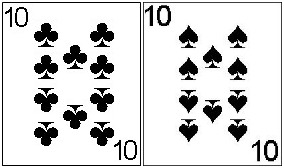 |
It should be noted, if attempting to beat one of the standard combinations with another standard combination, the play must be of the same type and contain the same number of cards. However, if beating a standard combination with one of the special combinations, or beating a special combination with another such special combination, the play need not contain the same number of cards nor even be of the same type, but simply must be of a higher rank as described in the table for the combinations. If a player's last two cards in hand are the two red tens these cannot be played as a red pig and only rank as a pair of tens.
 There is one exception to the normal turn-to-turn order of play during the game. After any player plays a combination consisting of a single card, any other player (not just necessarily the next in turn) may play a
pair of cards, of that same rank, to thus beat that single card combination. This play, if made, is considered higher priority than any other play, and thus takes precedence over any other play. This special play is called chata (kick) or jada. A chata can not be beaten by any other play except for the fourth and last card of that same denomination. Whatever player has that fourth card, if he prefers
and still retains the card in his hand, may immediately play that card (again out of turn if necessary) to beat the chata. Playing this fourth card is known as kkojda (insert) or kkota. This fourth card can not be beaten by any other combination. The player of the chata (or the kkojda if another player was able
to beat the chata with the fourth card of the same denomination) will then become the leader and start the next series of plays in which succeeding players will
then attempt to beat.
There is one exception to the normal turn-to-turn order of play during the game. After any player plays a combination consisting of a single card, any other player (not just necessarily the next in turn) may play a
pair of cards, of that same rank, to thus beat that single card combination. This play, if made, is considered higher priority than any other play, and thus takes precedence over any other play. This special play is called chata (kick) or jada. A chata can not be beaten by any other play except for the fourth and last card of that same denomination. Whatever player has that fourth card, if he prefers
and still retains the card in his hand, may immediately play that card (again out of turn if necessary) to beat the chata. Playing this fourth card is known as kkojda (insert) or kkota. This fourth card can not be beaten by any other combination. The player of the chata (or the kkojda if another player was able
to beat the chata with the fourth card of the same denomination) will then become the leader and start the next series of plays in which succeeding players will
then attempt to beat.
Once a player, through legal plays, manages to play the last card from his hand, he drops from the game, and the game continues with the remaining players, automatically skipping that player each time the turn rotates to that player. If the player who ran out of cards would be required to start the next round of plays (playing the highest, unbeaten combination during the series), the opportunity to lead the next series, rotates to the next active player with cards to that players immediate right.
Once the first three players have each depleted the hand of cards, the game ends. The last player should then show the remaining cards from his hand (in case it contains any red tens which are used to determine the temporary partnerships during that hand, if this is still unknown). Scoring for the hand then occurs, with cumulative points earned or lost by each player based on the ordering of finish of that player and the number of players forming the partnership in which the player was a member of. It should be remembered that there will always be two partnerships involved in each hand. The player or players having the red tens, and all the opponents of this player or players. The following charts show all such possible scoring variations which can occur at the end of each hand.
|
|
|
It should also be remembered that these scores may be doubled (x 2) if the red tens were intentionally exposed, and redoubled (quadrupled - x 4) if the opponents called "Stop" on a previous double.
After a set number of hands or set amount of time, the scores are compared and the player having the highest total accumulated score is declared the overall game winner.